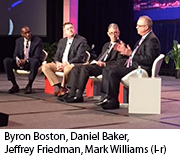
Capital Sources Converge on CRE
SAN DIEGO–The lines among different capital sources are becoming blurred as more and more money pursues commercial real estate, analysts said here at the MBA Commercial Real Estate Finance/Multifamily Housing Convention & Expo.
Debt funds, banks, life insurance companies, foreign investors, commercial mortgage-backed securities lenders and the government-sponsored enterprises are all pursuing commercial and multifamily investment, said Dynex Capital President and CEO Byron Boston, who also chairs the MBA Commercial Real Estate/Multifamily Finance Board of Governors.
“What’s happening now is there is a search for yield by institutional investors,” said Mesa West Capital Co-Founder Jeff Friedman. “They are trying to figure out where to put their capital. The combination of that and real estate fundamentals have been great.”
As a debt fund, Mesa West can offer large institutional investors both current income and downside protection, they are attracting more and more capital, Friedman said. “But the easier it is to raise capital, the harder it is to invest that capital,” he said. “That’s driving down costs so we are closer and closer to banks.”
Boston said like debt funds, banks are also pursuing loan growth. “They are not loosening their underwriting, but they will fight on pricing,” he said.
Friedman said life companies are entering the space traditionally occupied by debt funds. “You see MetLife, Principal, PGIM, Cornerstone and others; they’re all getting into the debt fund space by managing money for third-party institutional investors, not using their own balance sheet,” he said.
Mark Williams, Managing Director with intermediary Eastdil Secured, New York, agreed. “The fixed-rate core market of bidders has not changed,” he said. “Life companies and CMBS lenders, their pricing is very close. They are getting competition from debt funds that are tightening their spreads and becoming more competitive and maybe offering more leverage. We just closed a core deal with floating-rate paper; the life company came in at 130 basis points over LIBOR. You absolutely would not have seen that 10 years ago.”
KeyBank Real Estate Capital Executive Vice President Daniel Baker said the government-sponsored enterprises are also doing more lending on pre-stabilized assets than they used to. “Freddie Mac is securing loans and the biggest buyers are life companies,” he said. “There is a tremendous amount of cash out there looking to be put to work.”
In addition, more foreign capital is seeking U.S. real estate investment, Williams said. “The flow of money into the loan space is enormous; I don’t even have a measurement for it.”
Foreign-based investors often invest in debt funds rather than purchasing assets directly, Williams said. “They are viewed as a very safe investment for foreign entities, so you see tremendous demand.” Several years ago a wave of firms from South Korea tried to invest directly in U.S. commercial real estate properties, but they eventually found it easier to invest in funds, he said.
Foreign investors look to the U.S. for yield, Williams said, noting in Japan five-year bonds yield a negative 5 basis point return and 10-year bonds earn just 7 basis points. “In Germany, 10-year bonds pay 75 basis points compared to 285 basis points here. So money naturally finds a home in the debt market in the U.S.,” he said.
Friedman said three things for foreign capital to flow to the U.S. “First, there needs to be interest rate divergence so the search for yield exists. Second, relatively strong fundamentals, and the U.S. is viewed as a good place to invest. Third, a somewhat stable political system in which to invest. If any of these three did not exist, the spigot of funds could turn off.”
But even if the flow of foreign funds into U.S. CRE were to slow, the market would carry on, panelists said.
“Real estate is still the favored investment class,” Williams said. “It’s considered the number-one class of investment on their balance sheets, giving a better yield than alternative investments. So even without the big spigot of foreign capital, U.S. real estate fundamentals are fantastic. The U.S. is such a great area to invest in, it’s a large country with a stable government and laws that apply throughout the land. You can only do so much in Europe. And if you’re a big pension fund in Australia, there are only three big cities; you’ll run out of assets you can invest your capital in. So I don’t think foreign capital inflow will slow down, I think it is positioned very well.”
Baker agreed a major commercial real estate slump is unlikely even if foreign capital should slow down. “I don’t think you’ll see a major correction,” he said. “The market might run out of steam, but there won’t be a big correction.”
